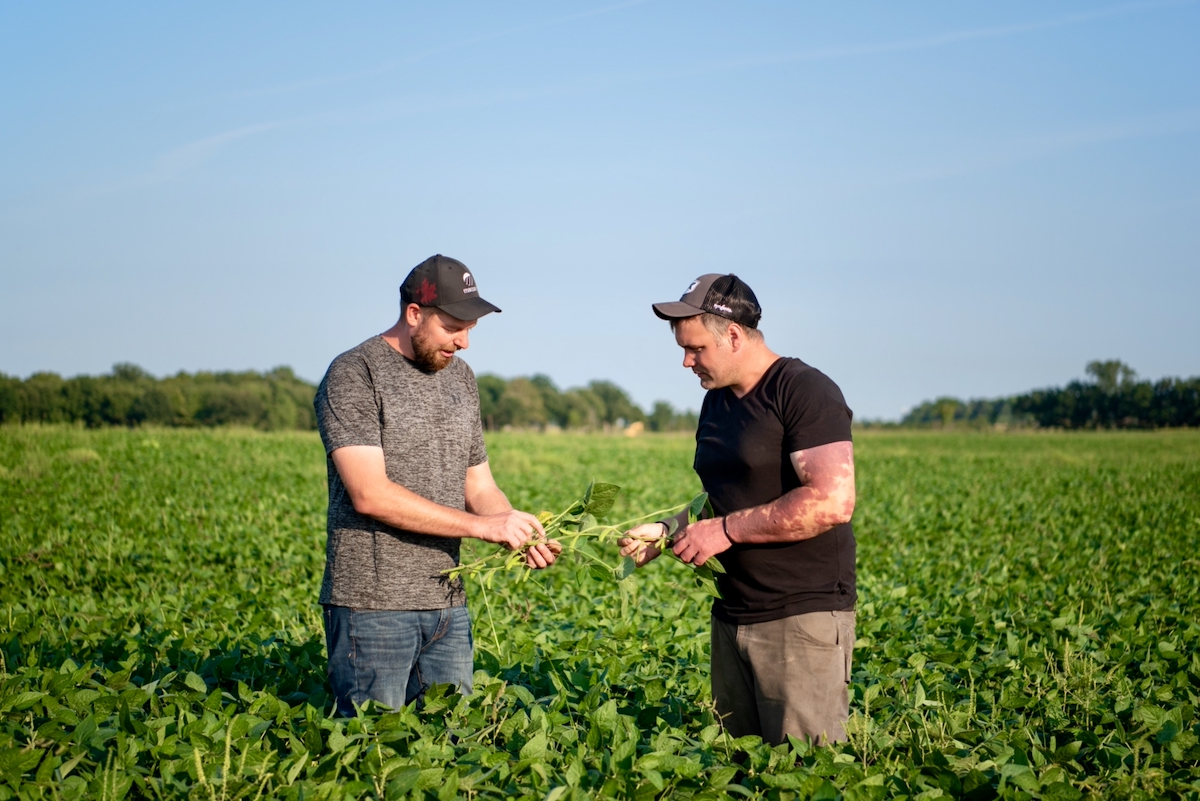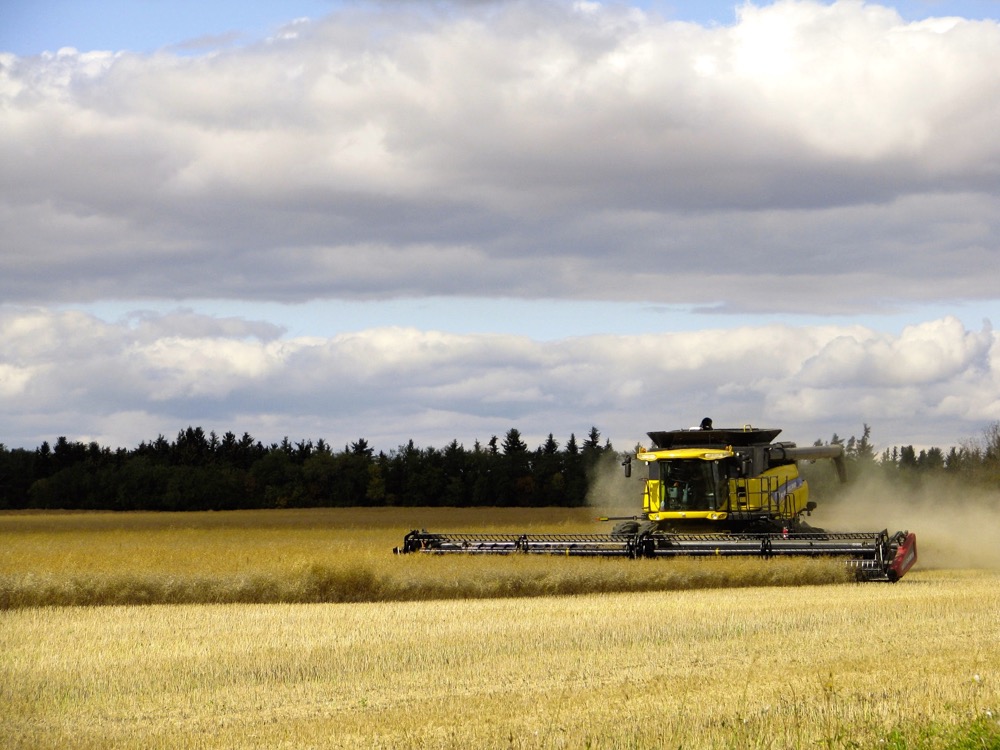Dale Beutler of Whitewood, Sask. did not have a good first experience straight combining canola. It was 2015. Like many canola fields in the area that year, the one he left standing for straight combining had been reseeded and was late. By the first week of October, stems were still green —even though seeds were ripe and dry — and harvest was excruciatingly slow.
“It might have been easier if I had waited a week or 10 days, but in October, you never know how many good harvest days you have left,” Beutler says.
Read Also

Ontario farmers partner for success
Ontario business partners, Matt Bergman and DJ Wassenaar, have been farming together for 10 years. Their focus on integrating unconventional…
The crop also had a pretty nasty lean to it, and was wrapping in one direction on his MacDon draper header. So Beutler combined the whole 50-acre field in the same direction. “A larger farmer would not have the patience, tolerance or time for that,” he says.
With so many mishaps, Beutler’s first crack at straight combining canola provided a lot of useful experience.
More and more canola growers are in the same test mode with straight combining canola, looking for a way to work it into their harvest program. Surveys found that 20 per cent or more of Canadian canola growers straight combined at least some canola in 2016. An increased level of grower experience, new research into headers and pre-harvest dry-down sprays, and new shatter-tolerant varieties are important factors in this shift.
James Humphris is crop manager for Bayer CropScience, a company that brought the shatter-tolerant trait to market. “We are on track with the prediction that 40 to 50 per cent of Canadian canola will be straight cut by 2020,” he says.
Beutler seeded a few fields in 2016 with every intention to straight combine them. Building on his 2015 experience, he seeded April 30 at a heavier seeding rate to keep plants small and maturity even and early. “That way, I wasn’t going to be stressing the harvest date,” he says. “I could give the crop the time it needed to dry down.”
Factors that increase the success rate for straight-combined canola, according to Canola Watch, are a uniform crop (helped at seeding time by good emergence rates and a decent plant population), a well-knitted crop with a slight lean, minimal weed growth, and low levels of plant disease. Good pod integrity is another factor. If a lot of pods have been damaged by frost, disease, hail or insect damage, the field may not be a good candidate for straight combining. Shatter-tolerant varieties help with pod integrity.
Four common questions
Chris Holzapfel, research manager at the Indian Head Agricultural Research Foundation (IHARF) in Saskatchewan, has done a few projects on straight combining canola. When talking to growers on this topic, four common questions are:
Q 1. Do I need to use pre-harvest herbicides or desiccants?
An IHARF demonstration in 2016 found no statistical difference in seed yield for treated versus untreated. But Holzapfel reports that treatment did reduce straw moisture and seed moisture, potentially speeding up harvest date and, most importantly, making harvest easier and reducing combining time.
That same year, Lorne Grieger, assistant vice-president with the Prairie Agricultural Machinery Institute (PAMI) location in Portage la Prairie, Man., led a study of pre-harvest aids. The treatments were Reglone, a Heat-glyphosate tank mix, and natural ripening. The variety was Bayer’s shatter-tolerant variety L140P.
PAMI compared cost, yield and quality, harvest timing, combine performance and losses for all three treatments and for a swathed check.
Straight combining with a Reglone treatment was $17.17 per acre more than swathing and combining. Heat plus glyphosate was $21.83 more, and natural ripening was $4.87 less. These costs include all machinery, manpower and product costs associated with swathing, spraying and combining.
“When doing their own economic analysis, producers should also consider costs that relate to the ability to schedule and predict harvest timing, ease of harvest, and operator experience,” Grieger says.
The PAMI study showed no statistical difference in yield for the four treatments. It was the same for quality: green seed was highest for naturally ripened, but it was within No.1 parameters for all treatments,.
Differences were more pronounced with harvest timing and combine efficiency. Reglone-treated plots were ready the same day as swathed treatments. Heat/glyphosate treated plots were harvested three weeks after application, but rain in the interim probably delayed harvest. Naturally ripened plots were ready for combining at the same time as the Heat/glyphosate treatments.
Combines burned more fuel per hour and were under greater load when harvesting straight cut versus swathed crop, but interestingly, the two sprayed trials allowed for more bushels per hour.
“Natural ripening required no swathing or spraying and provided cost savings, but high green matter in the stand made harvest difficult. Low, wet areas with higher weed populations were particularly frustrating for the operator,” Grieger says.
As for losses, very little (0.1 bu./ac.) occurred pre-harvest. Losses out the combine were higher for the Heat/glyphosate treatment (2.8 bu./ac.) than for the other three treatments, but Grieger thinks this is likely due to increased productivity (bu./hr.) of that treatment. For all treatments, losses tended to align with combine productivity.
The PAMI report concluded: “Straight-cut treatments with harvest aids had a higher cost of production, but the benefits of timeliness or ease of harvest may provide sufficient benefit to warrant this cost for certain operations. Similarly, in situations where control of timing is less of a concern, swathing or natural ripening harvest may prove to be the most economical.”
Beutler has taken a wait-and-see approach to pre-harvest treatment. He applied pre-harvest glyphosate around the headlands of one field to control kochia, but otherwise he has not used dry-down aids. “When I sprayed headlands, the weeds dried down nicely but I didn’t notice a significant difference in canola stalks,” he says. He combined about 12 days after spraying.
Beutler does, however, use a second shot of herbicide in the weed management window at the beginning of the season. “The cleaner the field, the better for straight combining,” he says.
He would consider a pre-harvest application across the whole field if it had uneven maturity or was weedy or green.
Q 2. Are there any storage issues with straight-combined canola?
Chris Vervaet, executive director with the Canadian Oilseed Processors Association, says a couple of members wonder whether straight-combined canola relates to higher green seeds and storage issues.
“There are some questions around whether the desiccation or dry-down products are being properly applied with regard to timing and leading to higher instances of green seeds and heated canola,” he says.
Angela Brackenreed, Canola Council of Canada agronomy specialist, wouldn’t directly correlate green seed with the act of straight cutting, but says early application of desiccants could certainly elevate green count.
“Anecdotally, there have been a lot of reports of more heating in canola that was straight cut,” she says. “The reasons for this are still unclear, but I don’t suspect it is related to green seed counts generally. Green weed seeds and green plant material are more likely, while other factors need further investigation.”
Q 3. What is the best header for straight cutting canola?
PAMI just finished a three-year study into headers, comparing harvest losses for rigid auger, draper and extended-knife headers.
“Producers ask if they can straight combine canola with the header they already have, and as a general rule, I would say ‘yes,’” says Nathan Gregg, project manager with PAMI. “Based on our experiment, all headers did the job within acceptable limits.”
But there is always room for improvement, he adds.
The header with extendable knife (PAMI used New Holland’s Varifeed in its study) showed some ability to minimize shatter losses, Gregg reports. He gives three reasons: (1) With the knife in front of the reel, it captured more of the losses from reel impact on dry pods. (2) Thanks to more space on the table for crop material, the header could be optimized for crop size. (3) The feederhouse will spit forward seeds as it grabs the crop. With more room in front of the feederhouse, more of these seeds will stay on the table.
PAMI also compared crop dividers. The Varifeed header had a vertical-knife divider, which had a benefit over rotary-knife and standard fixed dividers, in general. Gregg says this was particularly true when crop was very dry or lodged or both, but the standard divider worked well in moist conditions and slightly greener crop.
Q 4. What is the best variety for straight combining?
Any variety can be straight combined successfully under low-risk conditions, i.e. a well-knitted crop with good pod integrity, low winds and timely harvest.
IHARF compared 12 varieties from all herbicide-tolerance systems from 2011-13. In his report, Holzapfel concluded: “In years where conditions were challenging, such as the severe wind events in 2012 and higher than usual sclerotinia incidence, all of the cultivars were impacted and there were severe losses in all treatments.”
Data from harvest-delayed trials in 2011 and 2012 show losses from 3.0 bu./ac. for the best variety and 11.6 bu./ac. for the worst.
The IHARF trial added a shatter-tolerant variety in 2013 and 2014. “While overall losses were much lower in general during this period and all varieties were generally straight combined successfully, losses were consistently lowest with the shatter-tolerant hybrid,” Holzapfel says.
The PAMI header trial ran the same treatments for a shatter-tolerant variety and a similar-performing standard variety. “If you’re considering straight combining canola, shatter tolerance is a worthy endeavour,” Gregg says. “Benefits strictly due to this variety trait had a greater impact on straight combining success than any factor related to header choice or dividers.”
Beutler’s yield
Good decision-making depends on more than just one farmer’s results on a couple of fields in one little region. But since this article started with Beutler’s difficult first try with straight combining canola, it should end with a little mention of his yields.
In both 2015 and 2016, his straight-combined canola yielded three to four bu./ac. more than the average for his other fields, he says. Buoyed by these results, he will grow only shatter-tolerant varieties in 2017 with the goal of straight combining more acres.
“I’m a small farmer. Machinery cost is a big factor for me,” he says. Not having to buy a new swather is a motivator. And in his wide open area, he knows swathed canola has its own risks. “I’ve seen more canola swaths blow around the countryside than I care to remember,” he says.
As Beutler’s experience shows, a bad beginning is not a failure, but a chance to learn. With practical new research discoveries adding to these grower experiences, straight combining canola will become an effective and common practice in Western Canada.















